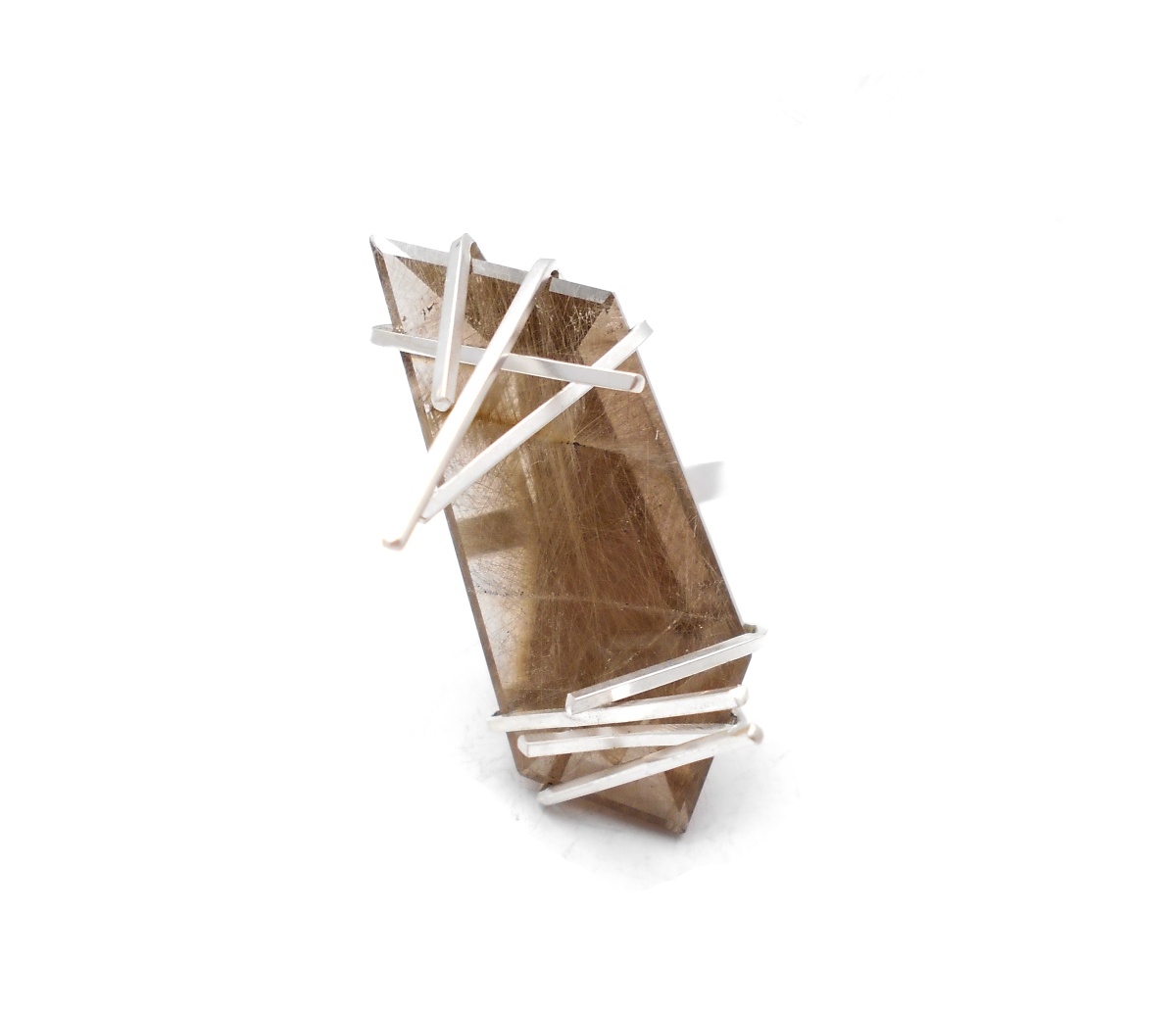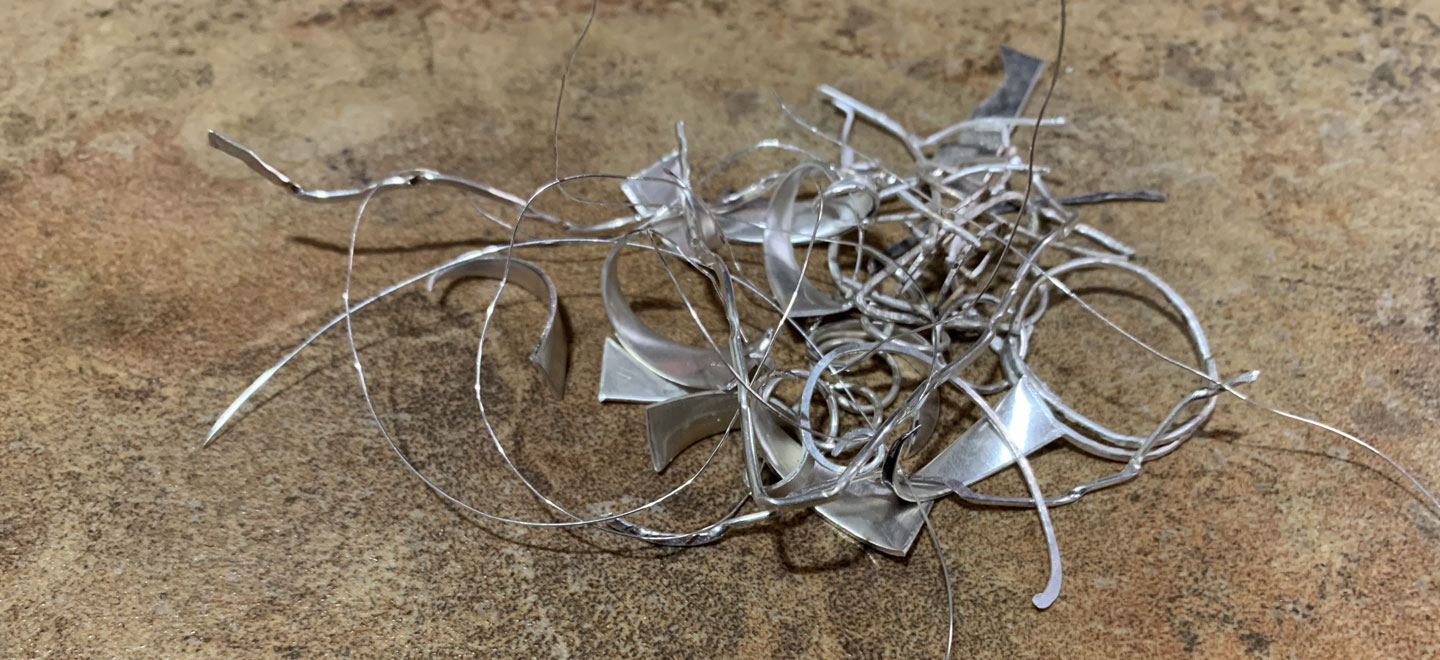Lessen your impact on the environment by learning about recycled & sustainable jewelry! Learn how to become more eco-friendly by making small, but important changes around your studio.
Awareness is at an all-time high right now. As we learn more about the impact our choices have on the environment, it is apparent that recycled and sustainable jewelry making is important to both designers and consumers. The impact of mining alone can be extremely hazardous to our land, water, and communities. Although mining is here to stay, many companies in the field are finding ways to lessen its impact and help communities at the same time. If these are important issues to you, the information and resources below will help you to explore sustainability in your own jewelry studio practice.
Sustainable Jewelry Making Q&A
I asked two of our previous Halstead Grant winners, Niki Grandics (NG) and Emily Shaffer (ES), what recycled and sustainable jewelry-making means to them, how they apply it in their studios, and what problems they have faced maintaining these standards in their jewelry businesses. Both jewelry artists have made sustainability a central focus for their production and marketing.

Q: Why is it important to you to use recycled jewelry?
A: (NG) Using recycled precious metals is important because no new mining was involved to source that gold and silver. It often brings new life to old jewelry and electronics components, allowing us to create something entirely new from it.
Q: How difficult has it been to find 100% recycled mill products?
A: (NG) Finding 100% recycled mill products like recycled sheet and wire thankfully has been pretty easy with most major suppliers carrying these. Finding 100% recycled chain and findings, however, have been considerably harder.
Q: What challenges have you faced finding resources?
A: (NG) Most suppliers don't list if a product is made from recycled content or let you easily search for recycled products on their websites. I've definitely picked up the phone and called suppliers a number of times to see if a specific product is made in house with recycled metals. They have the info and have always been quite helpful letting me know if it is or isn't, but it takes time and extra steps to find out, and if it isn't recycled, then extra time and effort to find an alternate product.

Tri-Shaped Earring Drops
Q: How do you minimize waste when you create?
A: (ES) I have a scrap bin that holds every single piece of metal waste that I create. At the end of the workday, I take a brush and pan to sweep up any silver dust that I may have created. This dust contains tiny metal particles that can be refined. ’Sweeps’ is a term we use for anything swept off the floor near your bench or tabletops. Metal filings and dust can make their way into many crevices in the studio. Everything including a paper towel used to wipe down the table can be put into a ’Sweeps’ bag. I save these bags so that I can at some point donate to CERF+.
I reuse packaging materials whenever possible. Plastic bags, boxes, and bubble wrap never get thrown away in my studio. If you take an extra second to neatly break down and organize these materials, it’s crazy how often you find a use for them! There are cases when I do need to purchase shipping materials for individual orders and brand consistency. I’ve purchased small shipping boxes from Eco Enclose. This company sustainably makes eco-friendly packaging. You can order custom boxes and bubble mailers.
Q: What are your environmental concerns?
A: (NG) My environmental concerns as they pertain to precious metals have to do with the way the land and water systems are affected by mining. Gold mining, in particular, can be some pretty dirty business, displacing land and polluting waterways with mercury and other toxic chemicals. While recycling gold is great and there is no new mining needed to obtain that gold, as an industry we need to do a better job of supporting mercury alternatives and mercury cleanup projects like the Mercury-Free Mining Project and Better Without Mercury. Even with all the use of recycled precious metals, new mining continues globally.
Q: What are your thoughts on sustainable stones?
A: (NG) The word sustainable is hard to apply to gemstones and precious metals as we are mining finite resources from the Earth, a practice that inherently isn't very sustainable. I think it's important to look at how these precious materials are mined in terms of their impact on the Earth, water, and the communities doing the mining, and look for suppliers who do right by all three. Ask your suppliers not only where their gems are mined, but who mined their gems, and what are they doing to reinvest in those communities. I've heard suppliers like Brian Cook from Nature's Geometry talk about regenerative agriculture around mining areas too, and how responsible mining can benefit everyone involved. In terms of sustainability and environmental impact, using reclaimed and recycled gems has the smallest carbon footprint since no new energy or mining was required to source them.
Sustainable Jewelry Making Resources
Chicago Responsible Jewelry Conference
Check out the groundbreaking advocacy work happening through the Chicago Responsible Jewelry Conference. Jewelry designer Susan Wheeler founded this group in 2017.
To engage everyone in the jewelry industry; miners, makers, professionals, educators, and students. To address all the ways that individuals and companies can be involved in the responsible jewelry movement. To make a difference by making things happen.
With annual conferences, they bring influential speakers from around the world to discuss the industry with the goal of creating changes while still benefitting everyone involved.
Ethical Metalsmiths & Radical Jewelry Makeover
Another excellent resource is Ethical Metalsmiths, which is a community of responsible jewelry makers that bring awareness to environmental concerns through education. They work closely in collaboration with Radical Jewelry Makeover, which was co-founded by Susie Ganch who is currently the Interim Chair for the Department of Craft/Material Studies at Virginia Commonwealth University. RJM is an international recycling and jewelry mining project. It has a remarkable way of promoting ethical mining issues by holding classes where participants bring unwanted jewelry. The class then deconstructs the jewelry and creates new pieces which are then sold with the profits donated to Ethical Metalsmiths. The collaboration between the two organizations has been a huge success.
Eco Jewelry Handbook
This popular resource book was written by jewelry artist and grant-winning educator, Christine Dhein. This quick-reference book helps you make healthy, safe, and informed decisions while maintaining a sustainable jewelry studio. In addition to her informative handbook, Christine also founded Green Jewelry News, an online website dedicated to educating and raising awareness about the environmental impacts and important news and events.
Federal Trade Commission
The FTC has put strict guidelines on recycling claims. It sets a high bar for businesses to substantiate environmental claims such as recycled content and eco-friendliness. Any such claims must be documented in detail to substantiate advertised benefits. Jewelers and suppliers must be careful not to overstate their sustainability in order to adhere to the federal truth in advertising guidelines. This is why it is difficult to source chain and findings that are made from recycled content. Distributors face many legal hurdles to making recycled content claims in product descriptions. These same restrictions apply to jewelers selling finished pieces. I highly recommend reading through them before making recycling claims on any of your items (including finished jewelry and packaging claims), specifically 16 CFR Part 260.13: Recycled Content Claims located in the Guides for the Use of Environmental Marketing Claims (A.K.A. Green Guides).
Starting a Sustainable Jewelry Making Studio
Jewelry making studios can be quite sustainable. As jewelers, we practice reusing and/or recycling our scrap, by melting it down or selling it for refining. I catch all of my sterling silver sweeps for rock salt casting or to use as dusting on a piece. Separate your copper and brass and sell it to a local scrapyard by the pound. Make sure your diamonds and gems are ethically mined or make the switch to lab-grown stones. If you want to take it a step farther, switch out your pickle for an all-natural, eco-friendly one, you can find a variety of recipes on the web. Do your research. check out the organizations listed above or search the internet for a slew of information.
Transparency at Halstead
At Halstead, recycling is important to us. Many of our silver sheet and silver wire options are 100% recycled. And we are proud of our recent investments around the office including, solar energy to power our facility and working to reduce plastic packaging.
About our Guests
Niki Grandics
Niki Grandics founded ENJI Studio Jewelry and was the 2016 Halstead Grant Winner. She is a member of Ethical Metalsmiths. All of her jewelry is made using recycled gold and silver, ethically sourced and fair mined stones, chains and findings made in the USA and Italy, and packaging and marketing materials made from recycled paper.
Emily Shaffer
Our 2018 Halstead Grant winner, Emily Shaffer, is a contemporary jewelry artist. She was a 2017 Halstead Grant Top 5 Finalist, an American Craft Week 30 Under 30 Rising Star, and was the recipient of the J. Allen Pawling Craft Memorial Award.
References:
FTC: Green Guides, Part VII: Guides for the Use of Environmental Marketing Claims; Final Rule, 2012 (October), Vol. 77, No. 197
Hilliard, H.E., 2003, Silver Recycling in the United States in 2000, Vol. 1.0








